-
Countries
-
Data and Analysis
-
Special Focus
-
Crisis Responses

Contact
IraqDTM@iom.int
Language
English
Location
Iraq
Period Covered
Jun 01 2020
Aug 31 2020
Activity
- Survey
- Flow Monitoring
DTM Iraq collects data at border crossing points with neighboring countries – the Islamic Republic of Iran (Iran), the Syrian Arab Republic (Syria) and Turkey – to better understand migration movements in the Middle East. Cross-border monitoring is drawn from IOM’s DTM standard methodology, designed to capture and describe migration flows, and is part of IOM’s DTM Regional Evidence for Migration Analysis and Policy (REMAP) project, funded by the European Union, which aims to capture and describe migration flows in Afghanistan, Bangladesh, Iran, Iraq and Pakistan. Data displayed in this report was collected in June, July and August 2020, employing two approaches: 1) headcount of all travellers entering or leaving Iraq, and 2) survey of randomly sampled travellers.
Border crossing points were selected based on observations conducted in May 2019 by IOM’s Rapid Assessment and Response Teams (RARTs), when five border crossing points were selected for data collection: Ibrahim Al-Khalil, bordering Turkey, Fishkhabour, bordering Syria, and Bashmagh Zurbatiyah (Wassit Terminal) and Al-Shalamcha, bordering Iran. Due to mobility restrictions imposed by Iraqi authorities since March 2020 aimed at curbing the spread of the coronavirus disease 2019 (COVID-19), data collection took place at three out of five selected border points in June, July and August 2020. Further details on the selection of respondents, survey methodology, and how the border crossing points were selected are available in the Methodological Overview in the last section of this report.
The report presents an overview of the overall movements of travellers observed at any of three selected border crossing points during June, July and August 2020. It is also focused in more detail on those travellers who are crossing the border for three or more months – they are referred to as migrants and comprise 49 per cent of all recorded travellers. Findings presented in this report relate to sociodemographic characteristics, reasons for travel and mobility history of this category of travellers.

Contact
DTM Iraq, IraqDTM@iom.int
Language
English
Location
Iraq
Period Covered
May 01 2020
Jul 31 2020
Activity
- Survey
- Displacement Solutions
- Mobility Tracking
This brief is part of a larger research project, Cities as Home, carried out by IOM Iraq, the Returns Working Group, and Social Inquiry, that explores both drivers and deterrents of integration across 14 urban locations that still host the largest share of IDPs in the country. The outputs of this project also include an analysis report on determinants of integration for IDPs and host community members, factsheets for each location, and four detailed case studies.

Contact
DTM Iraq, IraqDTM@iom.int
Language
English
Location
Iraq
Period Covered
Dec 31 2019
Feb 29 2020
Activity
- Survey
- Displacement Solutions
- Mobility Tracking
This set of factsheets provides a localised understanding of how conducive each of the 15 urban locations in Iraq hosting the largest share of out-of-camp internally displaced persons (IDPs) are for local integration. The inclusion of four case studies provides further insights into particular locations of interest. This interpretation of local integration takes into account the IASC Framework for Durable Solutions for Internally Displaced Persons criteria and expands upon it to include more subjective measures as well as the wider community in which the displaced live. 2 IDP and host community population figures referenced in the factsheets and case studies come from the IOM Displacement Tracking Matrix Masterlist Round 113, which corresponds to when nearly all data collection took place. Given COVID-19 restrictions, data collection in Sulaymaniyah City occurred in May 2020. The analysis presented here is predicated on the understanding of local integration as stemming from IDPs’ feelings of belonging to the hosting location as well as host community members’ acceptance of them over the long term and the regulatory landscape that surrounds both.1 It is based on an overall quantitative analysis of these locations, the household-level data collection of which took place between December 2019 and February 2020, conducted for the wider Cities as Home research project that identified the individual and place-related factors that drive or deter belonging and acceptance. These factors include societal, institutional, cultural, and socioeconomic indicators of the hosting locations and their populations. This analysis was further supplemented by detailing the instructions, regulations, and laws that are specifically related to the ability of non-camp IDPs to reside in cities in the country and enjoy the same rights as the host community.
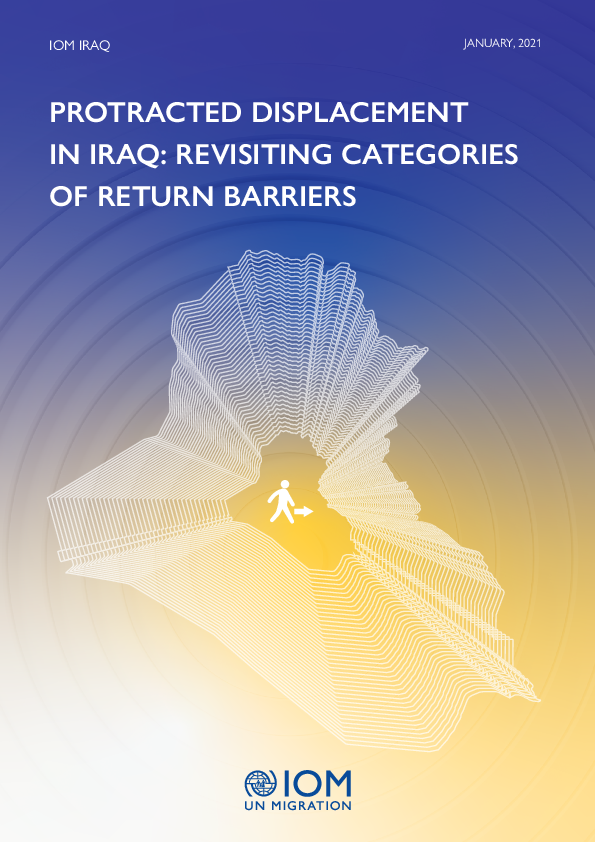
Contact
DTM Iraq, IraqDTM@iom.int
Language
English
Location
Iraq
Snapshot Date
Dec 31 2021
Activity
- Survey
- Displacement Solutions
- Return Intention
- Mobility Tracking
- Baseline Assessment
This report, Protracted Displacement in Iraq: Revisiting Categories of Return Barriers, is the second in this series and draws upon new literature and data that has been collected since Categorizing Protracted Displacement in Iraq was published. The aim of this report is to provide an updated evidence base to inform continued strategy development and monitoring relating to the resolution of IDPs in protracted displacement, through: • Providing an updated overview of the current IDP context in Iraq Providing an updated categorization framework and highlighting the different types of barriers faced by IDPs in returning to their areas of origin
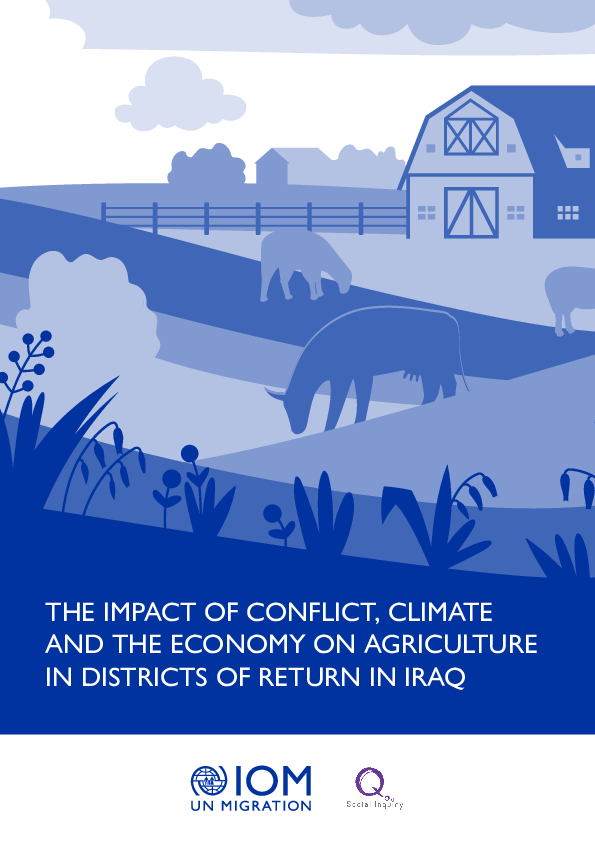
Contact
DTM Iraq, IraqDTM@iom.int
Language
English
Location
Iraq
Period Covered
Mar 01 2022
Apr 30 2022
Activity
- Survey
- Return Intention
- Mobility Tracking
- Baseline Assessment
This brief is part of a larger research project, Reimagining Reintegration, carried out by IOM Iraq and Social Inquiry, that explores the sustainability of returns across 14 districts hosting the largest shares of returnees in the country. These are, in descending order of returns, Mosul, Ramadi, Falluja, Telafar, Tikrit, Heet, Hawija, Hamdaniya, Shirqat, Kirkuk, Baiji, Sinjar, Khanaqin, and Balad. The findings presented here are drawn from an original household survey and roster of 2,260 returnee respondents in these districts collected between March and April 2022. The survey included a household module (applicable to the overall household situation), a personal module (gathering perceptions of the respondent), and a roster module (collecting personal characteristics of each household member), covering topics related to demographics, displacement and conflict history, safety and security, adequate standards of living, livelihoods and economic conditions, housing condition/restitution and tenure security, civil documentation, social cohesion and public participation, and remedies and justice. The outputs of this project also include an analysis of sustainable reintegration in districts of return and another brief on differences between male- and female-headed households and their implications for sustainable return.

Contact
DTM Iraq, IraqDTM@iom.int
Language
English
Location
Iraq
Period Covered
Mar 01 2022
Apr 30 2022
Activity
- Survey
- Return Intention
This brief is part of a larger research project, Reimagining Reintegration, carried out by IOM Iraq and Social Inquiry, that explores the sustainability of returns across 14 districts hosting the largest shares of returnees in the country. These are, in descending order of returns, Mosul, Ramadi, Falluja, Telafar, Tikrit, Heet, Hawija, Hamdaniya, Shirqat, Kirkuk, Baiji, Sinjar, Khanaqin, and Balad. The findings presented here are drawn from an original household survey and roster of 2,260 returnee respondents in these districts collected between March and April 2022. The survey included a household module (applicable to the overall household situation), a personal module (gathering perceptions of the respondent), and a roster module (collecting personal characteristics of each household member), covering topics related to demographics, displacement and conflict history, safety and security, adequate standards of living, livelihoods and economic conditions, housing condition/restitution and tenure security, civil documentation, social cohesion and public participation, and remedies and justice. The outputs of this project also include an analysis of sustainable reintegration in districts of return and another brief on the impacts of conflict, climate change and the economy on agriculture in districts of return
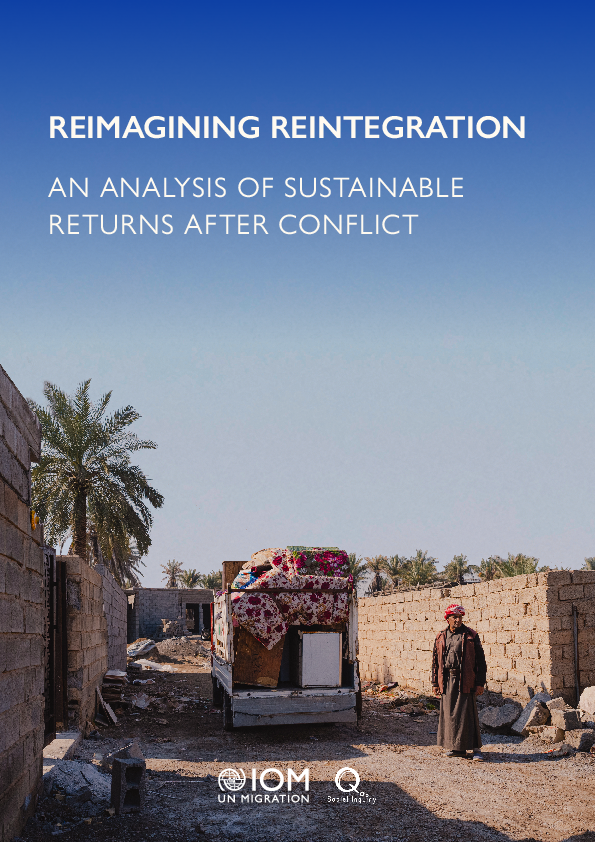
Contact
DTM Iraq, IraqDTM@iom.int
Language
English
Location
Iraq
Snapshot Date
Mar 22 2022
Activity
- Survey
- Return Intention
- Mobility Tracking
- Baseline Assessment
This report presents an overview of reintegration of returnees across the top 14 districts with the largest number of returnees; altogether, they represent more than 80% of the almost 5 million returnees that IOM’s Displacement Tracking Matrix estimated in March 20221 . This research was designed to obtain a statistically representative sample of the returnee population in each district with at most a 10% margin of error within a 95% confidence interval.

Contact
DTM Iraq, IraqDTM@iom.int
Language
English
Location
Iraq
Snapshot Date
Dec 30 2022
Activity
- Survey
- Return Intention
- Mobility Tracking
- Baseline Assessment
In February 2021, IOM Iraq, the Returns Working Group and Social Inquiry produced a report,Home Again?. The report analyzed the sustainability of reintegration of Iraqi families who had returned to their area of origin after being displaced due to the ISIL conflict. In line with the durable solutions framework developed by the Expert Group on Refugee and IDP Statistics (EGRIS), the report examined the extent to which sustainable reintegration had taken place across five areas.9 The study found that the main challenges to reintegration relate to housing, land and property (HLP); safety, security and social relations; and access to livelihoods and economic security. In 2021, IOM published a report and set of district profiles related to HLP, as well as a report focused on safety, security and social relations. Taken together, this series of reintegration reports – including this report focused on livelihoods and economic security – provides a comprehensive evidence base in support of the advancement towards sustainable reintegration for the 825,372 returnee families across the country.
The objective of this report is to strengthen the evidence-base related to the types of reintegration challenges related to livelihoods and economic security that returnees face across the country. The analysis is structured around the two relevant sub-criteria from the EGRIS framework, as follows: Livelihoods and employment and Economic Security.
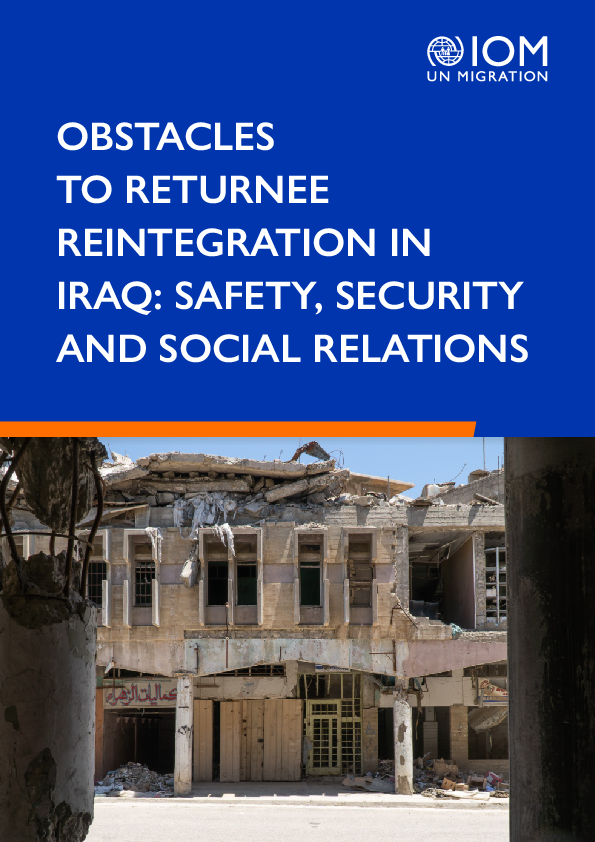
Contact
DTM Iraq, IraqDTM@iom.int
Language
English
Location
Iraq
Period Covered
Oct 01 2020
Sep 30 2021
Activity
- Survey
- Return Intention
- Mobility Tracking
- Baseline Assessment
In February 2021, IOM Iraq, the Returns Working Group and Social Inquiry produced a report, Home Again? Categorising Obstacles to Returnee Reintegration in Iraq. It analyzed the sustainability of reintegration for families who had returned to their area of origin after being displaced due to the ISIL conflict.5 In line with the durable solutions framework developed by the Expert Group on Refugee and IDP Statistics (EGRIS), the report examined the extent to which sustainable reintegration had taken place across five areas.6 Persistent issues related to safety, security and social relations were found to represent the most significant barriers to achieving sustainable reintegration amongst returnees in Iraq.
The objective of this report is to inform strategy development and planning in support of the sustainable reintegration of returnees in their area of origin. It provides a snapshot of the key reintegration challenges that returnees face related to safety, security and social relations, and highlights areas where these challenges are most prevalent. Where there is longitudinal data, the report also demonstrates how conditions have changed in the period between October 2020 and September 2021.
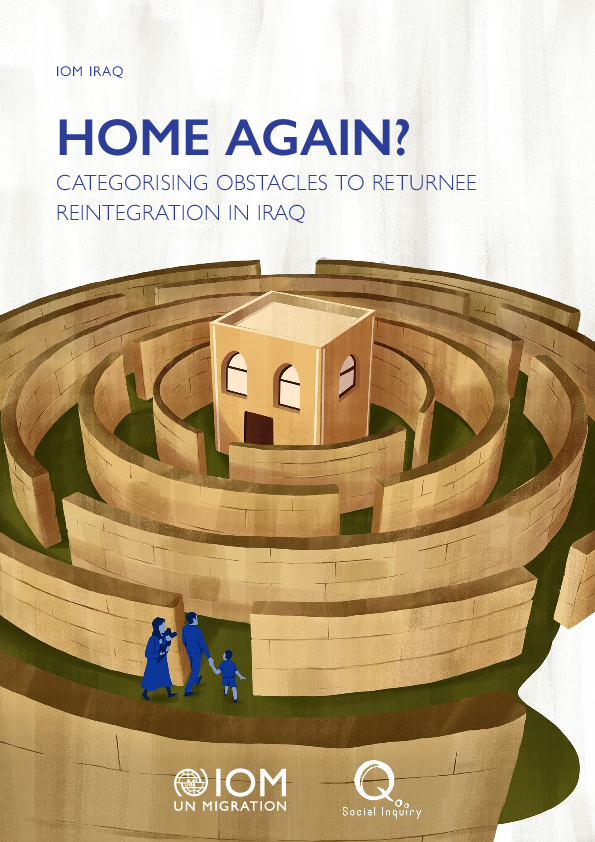
Contact
DTM Iraq, IraqDTM@iom.int
Language
English
Location
Iraq
Snapshot Date
Dec 31 2020
Activity
- Survey
- Return Intention
- Mobility Tracking
- Baseline Assessment
This report examines the prevalence of key obstacles for reintegration that returnee households face in Iraq as of mid-2020. These obstacles are grouped into five main criteria, as follows: safety, security & social relations, access to livelihoods & economic security, documentation, property resitution & compensation and adequate standard of living.
As of December 2020, Iraq has witnessed the return of 4.8 million internally displaced persons (IDPs) to their places of origin in the aftermath of the ISIL conflict. 1 Inter-Agency Standing Committee, IASC Framework on Durable Solutions for Internally Displaced Persons. Expert Group on Refugee and IDP Statistics, International Recommendations on IDP Statistics, background document to fifty-first session of the UN Statistical Commission, 3-6 March 2020. This is a significant returnee population and, while the movement home is a first step toward reintegration, it is not necessarily an indication of longer-term sustainability per se.1 The analysis in this report, by IOM Iraq, the Returns Working Group (RWG), and Social Inquiry, builds upon on and complements previous assessments on durable solutions, mainly with regards to obstacles to return as well as progress toward local integration for IDPs. The focus here is specifically on returnees and obstacles to their sustainable reintegration upon return.